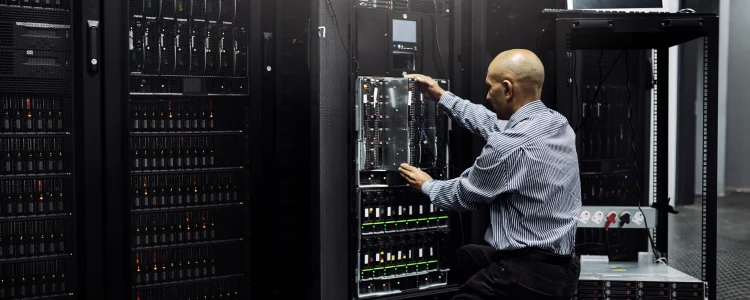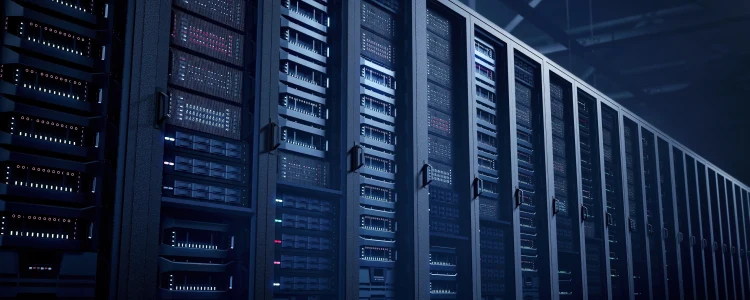What Hardware is Required for a Virtualization Server?

Did you know that more than 75% of server workloads across the world are running through server virtualization hardware? The tech industry is moving towards hardware virtualization more than ever, and with good reason. Boasting benefits like better server resource utilization, simplified management, reduced expenses, and fewer pesky physical servers to deal with, it’s no wonder it’s surged in popularity.
However, figuring out your company’s needs for server virtualization isn’t a straightforward process. Microsoft offers a guide to determine your server hardware requirements, but flowcharts can’t tell you what your teams need for their virtual servers. Thankfully, you don’t need a Cisco certification to choose the right server. If you know your way around the innards of a desktop, you’ve already got a pretty good idea of what you need.
This article serves not only as your handy guide to understanding these benefits but also dives deep into the depths of hardware requirements for hardware virtualization. We’ll break down the complexities of hardware selection, and discuss server specifications, CPU requirements, network considerations, and much more.
See Also: (Live Webinar) Meet ServerMania: Transform Your Server Hosting Experience
What is Hardware Virtualization?
Hardware virtualization is a method used to take a single physical server and divide it into multiple virtual servers that each run independently. These virtual machines have their own operating system and storage resources and act just as if they were physical servers, just like cloud server hosting. It’s a cost-effective way to deploy multiple virtual servers that utilize all of the physical resources of a single physical server.
Without hardware virtualization, physical servers only use a fraction of the computing resources they offer. Physical servers don’t run at full utilization 24/7. More often than not, workloads are distributed across the entire network, leaving many of them to simply sit idle until used. But by setting up virtual servers, you’re able to capitalize on that physical hardware and maximize how your company uses multiple physical servers.

What Virtualization Server Hardware Matters Most?
When you’re looking to set up server virtualization, the biggest factor will always come down to the hardware resources you’re providing to the virtual machines. A physical server uses all the same hardware that your standard desktop PC needs, but at a much bigger scale. Let’s dive into these components to give you a glimpse of what you should keep an eye out for.
CPU
Your server’s CPU is one of the most critical parts of server hardware. It’s the heart of the system, and it can directly impact the number and performance of the virtual machines you want to run. And with the massive array of CPUs on the market and the unique needs of your business, there isn’t one clear winner. Instead, you’ll need to keep an eye out for two factors: Cores and Clock speed.
More cores usually mean better performance, because they allow for multi-threading, which is great for an environment that will be running multiple virtual servers. Comparatively, the clock speed (measured in GHz) determines how fast the CPU can process things. Higher clock speeds can boost efficiency and overall speed for your virtual machines. You’ll want to find a healthy balance between both cores and clock speed for best performance.
As an example, you’ll receive better efficiency from two CPUs with 2.4 GHz and 10 cores than you will from two CPUs with 3 GHz and 4 cores. You should only consider investing in faster CPUs when your workload demands it.
Memory/RAM
Every virtual machine you run lives in memory and needs its own allocation to use, which is why it’s so critical to your physical server. The more memory you have, the more VMs it can run (and how efficient they are). Server virtualization needs a lot of RAM, and you’ll still need a buffer on top of it for increased workloads. When considering RAM, you’ll want to keep these in mind:
- How much RAM do you need? Your physical server and server virtualization software both need memory to run, but so do the virtual machines running on it. You should estimate how much RAM you’ll need, based on current and future needs for your physical hardware. If each workload is 2GB, and your CPU has ten cores, you’ll need 80GB of RAM just to run the workloads, not counting the operating system or virtual servers.
- What memory type do you want? Currently, there are three different types of RAM — DDR3, DDR4, and DDR5. Each of these is faster and more power-efficient than its previous iteration, but they also come at a higher price too. As a rule of thumb, DDR3 is the cheapest, while DDR4 is the best bang for your buck thanks to its upgrades over its older version.
Network Access
Having a robust network interface is crucial to facilitating communication between other virtual servers and other systems. With virtualization software, it’s fairly common for multiple virtual machines to share a single interface, making network access even more important. When looking at hardware, consider these:
- Bandwidth – The higher the bandwidth, the more data you can transfer from your virtual machine. If you don’t have enough to support multiple VMs, you’ll end up creating bottlenecks and strain on your physical server.
- Network Interface Card (NIC) – How many, and what kind of NICs you have matters significantly. They’re the physical part that connects your server to a network. You may need multiple network interfaces if you need to segregate traffic for fault tolerance. The type matters too. While you can probably get by with your standard Gigabit Ethernet NIC for now, you’ll get better performance with an upgrade.
- Redundancy and load balancing – Implementing strategies for both of these can help prevent network failures and increase performance. Load balancing can manage your network traffic more efficiently, ensuring that VMs don’t create a monopoly on your network resources. Installing multiple NICs or using NIC teaming can help protect against hardware failure by providing alternative paths.

Best practices for server virtualization
To guarantee the success of your server virtualization deployment, following best practices during the entire process — from planning to maintenance — is crucial. Thankfully, we’ve got a few tips for you to keep in mind.
Planning and Assessment
These serve as the blueprint for server virtualization work. Begin by conducting a thorough investigation of your existing infrastructure, server resources, and workloads. Make sure to identify potential bottlenecks or areas that may need improvements. Planning ahead matters too. Anticipate future needs by examining factors like expected workload growth, regulatory requirements, and overall business needs, too.
Defining Goals
With the insights from your assessment, focus on defining clear, measurable, and achievable objectives for your virtualization project. These goals might range from cost reduction, resource optimization, improved efficiency, what types of server virtualization you need, and how you want to configure your virtual server.
Selecting the Right Hardware for Your Needs
The importance of choosing the optimal server hardware for your physical machine cannot be overstated. Strive for a balance between CPU, memory, storage, and network capabilities, tuned to meet your performance requirements. Remember to ensure the hardware you select is compatible with your chosen virtualization software to get optimal performance and functionality.
Utilizing Virtualization Management Tools
Specialized software tools such as VMware vSphere, Microsoft System Center, or Proxmox VE can play a crucial supporting role, depending on your chosen hypervisor. These tools centralize the management of your virtual environment, enabling more efficient monitoring, troubleshooting, and resource optimization.
Regular Maintenance and Support
Creating a routine for periodic hardware and software maintenance is a best practice that ensures system health and performance. Equally important is to keep your system up-to-date by applying security patches and updates regularly. Active monitoring of system performance will help you spot and solve issues before they have a chance to escalate. Plus, you will want to work with a vendor that offers excellent customer support, in case of disaster.
Achieving full virtualization
Server virtualization continues to revolutionize the tech industry, turning physical hardware into virtualized systems that run across multiple operating systems and making effective use of server resources. When it comes to deciding how you want to build that underlying hardware, there are three parts that require the most attention; CPU, Memory, and network interfaces, which all factor into the efficiency of your virtual server.
These aren’t the only factors, though. You’ll also need to make a plan for your server hardware, and the types of server virtualization you’ll need. Plus, you’ll still need to consider the right virtualization management software, and maintaining those physical resources. By aspiring to these best practices, you’re placing yourself in an excellent position to make the most of server virtualization’s immense potential.
If you enjoyed this read, check out our other fantastic articles about servers.
Was this page helpful?

